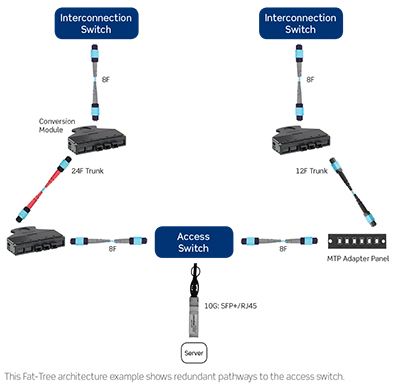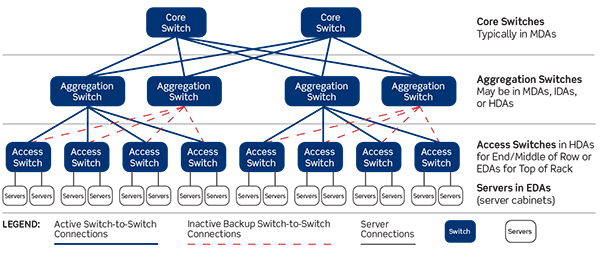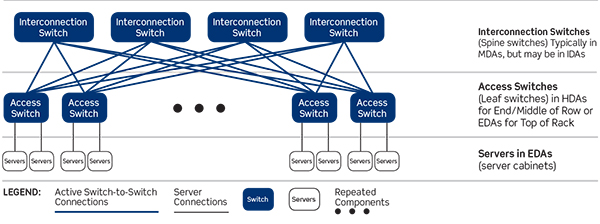|
TIA Standards Highlight New Switch Fabrics The Traditional 3-Tier Architecture Model
Fat-Tree Architecture (also known as Leaf Spine)
 Other new switch fabric architectures also provide lower latency, higher bandwidth, and include non-blocking ports between any two points in a data center. Additional examples of emerging architectures included in the ANSI/TIA-942-A-1 published standard include:
Impact Pre-terminated 12- or 24-fiber MPO/MTP® cabling is ideal for supporting higher bandwidth requirements in data centers using these architectures. It ensures cabling design maximizes fiber utilization throughout the infrastructure, and also promotes an easy migration path to support current or future IEEE 40G and 100G bandwidth as required by ANSI/TIA-942-A-1 standards. New, lower-cost transceiver technology has recently been developed to work in tandem with pre-terminated 12- or 24-fiber MPO/MTP® cabling to support higher levels of performance and accommodate data center links over 150 meters. These multimode transceivers can transmit longer distances using the same cable (up to 300 meters over OM3 and 400 meters over OM4). Using pre-terminated MTP® cabling and connectivity, Leviton performed active testing at customer data centers with Cisco and Arista switches that include these transceivers, and confirmed that 10G and 40G channels both worked at stated distances with zero errors and no lost data packets. To support new architectures and scalability, IEEE is working on new physical layer requirements. The IEEE P802.3bm task force is currently developing standards to support next generation 40/100GbE technologies that lower costs, reduce power consumption, and increase density. It is critical to understand the impact of these new architectures and standards on your data center and prepare a migration strategy for moving to 40G, 100G, and beyond. To learn more about migration and these new architectures, contact Accu-Tech today.
|
{% set baseFontFamily = "Open Sans" %} /* Add the font family you wish to use. You may need to import it above. */
{% set headerFontFamily = "Open Sans" %} /* This affects only headers on the site. Add the font family you wish to use. You may need to import it above. */
{% set textColor = "#565656" %} /* This sets the universal color of dark text on the site */
{% set pageCenter = "1100px" %} /* This sets the width of the website */
{% set headerType = "fixed" %} /* To make this a fixed header, change the value to "fixed" - otherwise, set it to "static" */
{% set lightGreyColor = "#f7f7f7" %} /* This affects all grey background sections */
{% set baseFontWeight = "normal" %} /* More than likely, you will use one of these values (higher = bolder): 300, 400, 700, 900 */
{% set headerFontWeight = "normal" %} /* For Headers; More than likely, you will use one of these values (higher = bolder): 300, 400, 700, 900 */
{% set buttonRadius = '40px' %} /* "0" for square edges, "10px" for rounded edges, "40px" for pill shape; This will change all buttons */

 Demand for faster speeds and greater bandwidth is always increasing, along with the exponentially increasing number of network connections. Equipment architecture trends are also changing, and thus TIA standards must accommodate.
Demand for faster speeds and greater bandwidth is always increasing, along with the exponentially increasing number of network connections. Equipment architecture trends are also changing, and thus TIA standards must accommodate. 


.png?width=58&height=58&name=X_logo_2023_(white).png)
